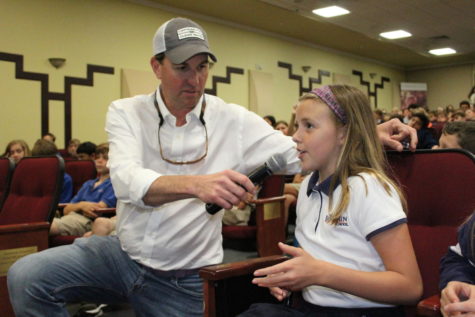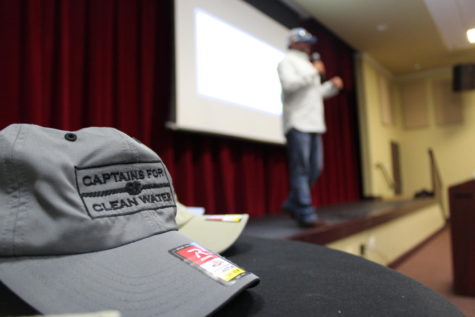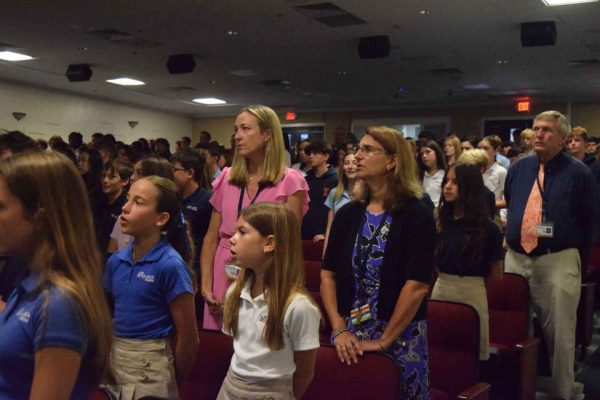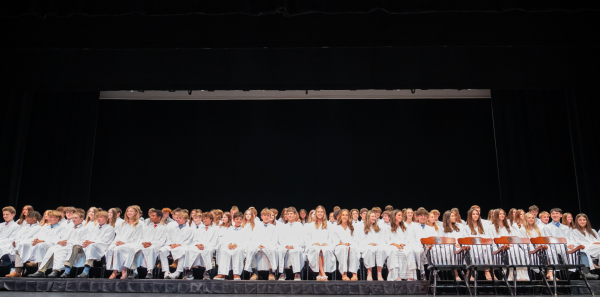Students Get Everglades Education at Special Assembly
Boat captain Chris Wittman explains the dire state of the Everglades to the middle school students on August 4.
No matter what your age, you’re never too young to make a difference. Meriel Smith, a sixth grader, has spent the last year championing the cause of Captains for Clean Water, an organization whose mission is to restore the Everglades to its natural flow into the Florida Bay and keep Florida’s waterways clean. Smith’s father, Mr. Sawyer Smith, is also a part of the organization, and together, they are trying to help Florida’s ecosystem.

Sixth grader Meriel Smith has made the Everglades restoration a top priority.
As a result, Smith’s father, along with Chris Wittman – a local captain and fishing guide – came to speak to the middle school students about Captains for Clean Water and their efforts on May 4 in the Barker Performing Arts Center.
“I have grown up on the water,” said the Benjamin sixth grader, “and my dad is friends with a lot of fishing guides, so I’ve always been a part of Captains for Clean Water.”
However, Smith’s desire to help clean up the Everglades and Florida’s waterways stems from a more personal source.
“Recently, my dog was diagnosed with bladder cancer,” she said. “It is not for sure, but she used to swim in a river that flowed out of Lake Okeechobee, and I think that the polluted water was the reason she developed cancer. Even though chemotherapy and radiation worked, ever since then, I have wanted to do anything that I can to help fix Lake Okeechobee and the Everglades. I guess [also] seeing the effects on the Everglades has made me want to do something more to help.”
Because of the development of South Florida over the past hundred years as more and more people have built homes and businesses, the natural southern water flow from Lake Okeechobee has been siphoned to the east and the west. As a result, the Everglades has not received a healthy flow of water, affecting the area’s wildlife and ecosystem. In addition, because of the fertilizers used by the surrounding farmlands, the harmful chemicals and pollutants have leached into the Everglades, further damaging the environment and wildlife.

Mr. Smith holds the microphone for sixth grader Hannah Beam so she can ask Mr. Wittman a question.
According to the United States Environmental Protection Agency (EPA), Lake Okeechobee has an acidic pH water level of 5.0 (neutral is 7.0, so the smaller the number, the higher the acidity level). Most lakes have pH levels ranging between 6.5-8.5. This acidity level is dangerous for the animals living and coming into contact with the lake.
In addition, the excessive nitrogen and phosphorus runoff from the surrounding agricultural areas creates dangerous algae blooms that suffocate the Everglades’ water-based organisms.
“The [Florida] Bay is very lifeless where the bloom looks the worst,” said Pete Frezza, a fishing guide and Everglades research manager for Florida Audubon who was quoted by the Miami Herald in November 2017. “It’s just a desert out there.”
According to the www.captainsforcleanwater.org, “The murky, turbid Lake Okeechobee discharge water also kills seagrass, oysters and other life on the seafloor. It blocks light from reaching the seagrass and prohibits photosynthesis.”
Smith, along with her father and other representatives from Captains for Clean Water, traveled to Tallahassee earlier this year to speak to politicians, trying to convince them to build an infrastructure which would allow the water from Lake Okeechobee to flow south.

Mr. Wittman and Mr. Smith brought hats and stickers which were given to the faculty at the end of the program. In addition, the men told students that if they took a picture with a Captains for Clean Water sticker near a body of water and posted it to social media, the organization would send them a free hat.
During the May 4 assembly in the BPAC, Wittman told the students how he and other members of Captains for Clean Water introduced to Florida lawmakers the idea of building a manmade filter south of Lake Okeechobee to filter the algae and pollutants flowing through the Everglades. Hopefully, this will also re-establish the natural, southern flow of water from Lake Okeechobee. The state of Florida has agreed, but, because the Everglades is a national park, the state needs to request aid from the federal government and find out for which portion of the project it is financially responsible. The state hopes the federal government will split the cost 50/50.
“It’s important that [the Everglades restoration] takes place,” said Smith, “so that we can solve this issue and move on to the next thing.”





